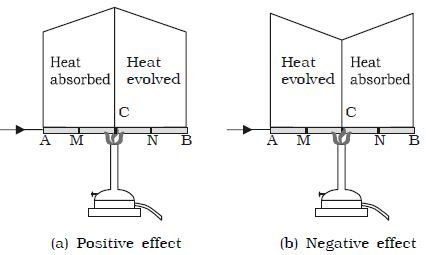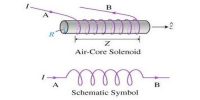Thomson suggested that when a current flows through unequally heated conductors, heat energy is absorbed or evolved throughout the body of the metal.

Fig: Thomson effect
Consider a copper bar AB heated in the middle at the point C and current flowing as shown in Fig: a. When no current is flowing, the point M and N equidistant from C are at the same temperature. When current is passed from A to B. N shows higher temperature compared to M. Similarly, B will show higher temperature as compared to A. It means from A to C heat is absorbed and from C to B heat is evolved.
This is known as positive Thomson effect. Similar effect is observed in the case of Sb, Ag, Zn, Cd, etc. When the current is passed from B to A, M will show higher temperature as compared to N.
In the case of Iron (fig: b), when it is heated at the point C and current is flowing from A to B, M shows higher temperature as compared to N. It means from A to C, heat is evolved and from C to B heat is absorbed. This is negative Thomson effect. Similar effect is observed in the case of Pt, Bi, Co, Ni, Hg, etc.
If we take a bar of lead and heat it at the middle point C, the point M and N equidistant from C show the same temperature when current is flowing from A to B or from B to A. Therefore, in the case of lead, Thomson effect is nil. Due to this reason, lead is used as one of the metals to form a thermo couple with other metals for the purpose of drawing thermo electric diagrams.













